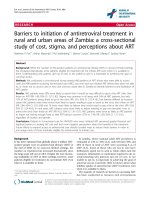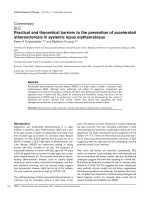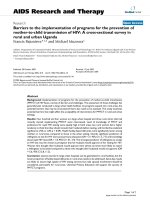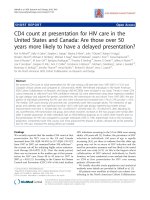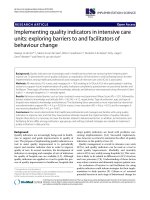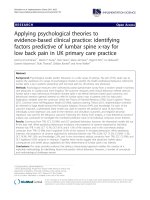Perceived stigma and barriers to care in UK Armed Forces personnel and veterans with and without probable mental disorders
Bạn đang xem bản rút gọn của tài liệu. Xem và tải ngay bản đầy đủ của tài liệu tại đây (514.47 KB, 7 trang )
Williamson et al. BMC Psychology
(2019) 7:75
/>
RESEARCH ARTICLE
Open Access
Perceived stigma and barriers to care in UK
Armed Forces personnel and veterans with
and without probable mental disorders
Victoria Williamson1*, Neil Greenberg1† and Sharon A. M. Stevelink1,2†
Abstract
Background: Previous studies have found that perceptions of mental health related stigma can negatively impact
help-seeking, particularly in military samples. Moreover, perceptions of stigma and barriers to care can vary between
individuals with different psychiatric disorders. The aim of this study was to examine whether perceptions of stigma
and barriers to care differed in a UK military sample between those with and without a current likely mental health
diagnosis.
Method: Structured telephone interviews were carried out with 1432 service personnel and veterans who reported
recent subjective mental ill health in the last 3 years. Participants completed self-reported measures relating to
perceived stigma, barriers to care and psychological wellbeing.
Results: Those meeting criteria for probable common mental disorders (CMD) and PTSD were significantly more likely
to report concerns relating to perceived and internalised stigma and barriers to care compared to participants without
a likely mental disorder. Compared to individuals with likely CMD and alcohol misuse, those with probable
PTSD reported higher levels of stigma-related concerns and barriers to care – although this difference was
not significantly different.
Conclusions: These results indicate that perceptions of stigma continue to exist in UK serving personnel and
military veterans with current probable mental disorders. Efforts to address particular concerns (e.g. being seen as weak;
difficulty accessing appointments) may be worthwhile and, ultimately, lead to improvements in military personnel and
veteran wellbeing.
Keywords: Stigma, Barriers to care, Attitudes, Military personnel, Veterans, Mental health, Post-traumatic stress disorder,
Common mental disorders, Alcohol misuse
Background
Mental health-related stigma and a lack of trust/confidence in mental health providers has been found to be an
important barrier preventing access to necessary psychological care in several high pressure occupations, including
healthcare providers, first responders and military
personnel [1, 2]. In recent years, the underutilization of
mental health services by serving and ex-serving military
personnel has received growing research attention [3–5].
* Correspondence:
Neil Greenberg and Sharon AM Stevelink are joint last authors.
1
King’s Centre for Military Health Research, Institute of Psychology, Psychiatry
and Neuroscience, King’s College London, 10 Cutcombe Road, London SE5
9RJ, UK
Full list of author information is available at the end of the article
In both US and UK military samples, perceptions of mental health stigma, self-reliance and concerns that seeking
mental health services may negatively impact one’s military career and have been identified as key reasons for not
seeking psychological treatment [6]. Several types of
stigma exist which are thought to interact and contribute
towards barriers to help-seeking [7]. Common types of
perceived stigma include public stigma, internalised
stigma and structural discrimination. Public stigma, where
others endorse prejudice against those with mental health
problems [8], in an Armed Forces (AF) context can relate
to concerns of being perceived as less competent by colleagues or experiencing differential treatment by unit
leaders. On the other hand, internalised stigma occurs
© The Author(s). 2019 Open Access This article is distributed under the terms of the Creative Commons Attribution 4.0
International License ( which permits unrestricted use, distribution, and
reproduction in any medium, provided you give appropriate credit to the original author(s) and the source, provide a link to
the Creative Commons license, and indicate if changes were made. The Creative Commons Public Domain Dedication waiver
( applies to the data made available in this article, unless otherwise stated.
Williamson et al. BMC Psychology
(2019) 7:75
when an individual with mental health difficulties internalises negative stereotypes held by society resulting in
poorer self-esteem and feelings of shame [9, 10]. In an AF
context, commonly described internalised stigma beliefs
include ‘I am weak’ and ‘I am crazy’ [7]. Finally, structural
discrimination can be experienced when an organisation’s
regulations may (un)intentionally disadvantage those with
mental health difficulties [11]. Examples of structural
discrimination can include perceived difficulty taking time
off work for an appointment or a lack of resources to
access help [7].
The recent research studies focusing on mental health
and stigma have contributed towards the promotion of
mental health-related discussions, with various campaigns run within the military (i.e. “don’t bottle it up”)
and general public (i.e. “no health without mental
health”, “mental health matters”) in an effort to reduce
mental health stigma and encourage help-seeking [12].
There is some evidence that stigma-related beliefs can
vary between individuals with different psychiatric disorders. For example, Iversen et al. [5] found serving and
ex-serving personnel with post-traumatic stress disorder
(PTSD) were more likely to report more internalised
stigma and barriers to psychological care compared to
individuals with non-PTSD mental health problems and
those without a diagnosis of a mental disorder [5]. An
examination of whether mental health-related stigma
perceptions continue to vary by mental disorder may inform future interventions to more effectively reduce
stigma and improve help-seeking. The present study
aimed to examine perceptions of stigma and whether
rates of perceived stigma, internalised stigma and barriers to care differ in a UK military sample with current
probable PTSD, depression, anxiety, or alcohol misuse
and those without a likely mental health disorder.
Methods
Ethical approval was sought and obtained from the UK
Ministry of Defence Research Ethics Committee (ref:
535/MODREC/14).
Participants
The present tri-service sample was based on a large sample of regular, reserve and veteran UK AF personnel
who completed the third phase of an existing cohort
study [13] Further details regarding the cohort study are
described by Fear et al., 2010; Hotopf et al., 2006; and
Rona et al., 2006 [14–16]. The sample for the current
study was drawn from the pool of individuals in phase
three who gave consent to future contact and answered
‘yes’ to the question, ‘have you had a mental health,
stress or emotional problem in the past three years?’. Of
the 2030 eligible participants, 1713 were selected for inclusion. Of these, 263 did not complete the interview
Page 2 of 7
and two interviews were lost during a computer service
error. Sixteen participants were ultimately not included
in the final analysis as they did not meet inclusion criteria. This resulted in a final sample of 1432 participants
(83.6% response rate).
Procedure
The study procedure is described in-depth by Stevelink
et al. [17]. As an overview: information and invitations
to participate were sent to participants and consenting
participants completed a structured telephone interview
with responses entered into a secure electronic study
database. Study interviews were audio-recorded with
participant consent. The interviews lasted between 17
and 148 min (median = 38.5 min). As a thank you for
their time, participants received a cheque for £25 (USD
$35) on completion of the interview. Data collection was
conducted between February 2015 and December 2016.
Materials
Items from the Perceived Stigma and Barriers to Care
for Psychological Problems – Stigma Subscale (PSBCPPSS), the Barriers to Access Care Evaluation (BACE)
measure, and the Self-stigma of Seeking Psychological
Help (SSOSH) scale were used to assess mental healthrelated stigma and barriers to care [3]. Participants were
asked to respond to statements relating to i) access to
mental health services (4 items), ii) internalised stigma
of mental illness (7 items), and iii) perceived stigma of
mental health care/providers (9 items; Additional file 1:
Table S1). A 5-point Likert scale was used with responses ranging from 1 (strongly disagree) to 5 (strongly
agree). Scores were reverse coded to ensure that a higher
total score on each subscale indicated a higher perceived
level of barriers to care, perceived stigma and negative
attitudes. Responses on the measures of stigma were
grouped into ‘agree’ (agree and strongly agree) and ‘disagree’ (disagree and strongly disagree). Responses of ‘neither agree nor disagree’ were excluded from this analysis
[5]. Three scales (access to mental health services; internalised stigma of mental illness and perceived stigma of
mental health care/providers) were created by summing
the items pertaining to each domain to create a summary score (see Additional file 1: Table S1). The scale
has been widely used among military personnel with
good reliability and validity [3, 18].
To determine probable mental health disorders, the
Patient Health Questionnaire (PHQ-9 [19]) was used to
assess depression symptoms (cut off score of ≥15), the
Generalized Anxiety Disorder scale (GAD-7 [20]) was
used to assess anxiety symptoms (cut off score of ≥10),
the PTSD checklist for DSM-5 (PCL-5 [21]) was used to
assess probable PTSD (cut off score ≥ 38), and the Alcohol Use Disorders Identification Test (AUDIT-C [22])
Williamson et al. BMC Psychology
(2019) 7:75
Page 3 of 7
was used to assess likely alcohol misuse (cut of score of
≥10 to indicate substantial alcohol misuse consistent
with previous studies in military samples; e.g. [23]).
Table 2 OR and AOR for stigma scale summary scores for
individuals meeting case criteria for likely PTSD, alcohol misuse,
and common mental disorders versus those who did not meet
criteria for each disorder
Analyses
Stigma scales
Descriptive analyses were conducted to provide an overview of the sample characteristics (Table 1). To compare
perceptions of stigma and barriers to care amongst those
with and without mental health problems, unadjusted
and adjusted ratios as well as 95% confidence intervals
are provided in Table 2. Odds ratios were calculated
using logistic regression analysis and were adjusted for
socio-demographic characteristics (age, sex). As individuals could meet likely criteria for more than one
disorder, overlapping 95% confidence intervals (CI) were
used to indicate non-significant differences in scores.
Common Mental Disorders (CMD) reflects participants
who met case criteria on the GAD-7 and/or the PHQ-9.
To account for non-response, response weights were
generated based on variables shown to be associated
with responding (i.e. age, rank and Service). Response
weights were calculated as the inverse probability of
Access to mental health services
Table 1 Participant demographic characteristics
Index
N(%)
Mean age (SD)
41.6 (9.4)
Gender, n (%)
Male
1213 (84.7%)
Female
219 (15.3%)
Serving status, n (%)
Serving
783 (54.7%)
Left service
649 (45.3%)
Service branch
Royal Navy or Royal Marines
197 (13.1%)
Army
937 (65.9%)
Royal Air Force
314 (21.0%)
Rank
Officer
378 (26.4%)
Non-commissioned officer
867 (60.5%)
Junior rank
187 (13.1%)
Service type, n (%)
1167 (81.5%)
Reserve
265 (18.5%)
Met likely diagnostic criteria, n (%)
PTSD
124 (8.7%)
Alcohol misuse
266 (18.6%)
CMD
Alcohol misuse
CMD
1.81 (1.37; 2.39) 1.15 (0.91; 1.45)
1.57 (1.26; 1.97)
AOR (95% CI) 1.82 (1.38; 2.40) 1.17 (0.92; 1.49)
1.56 (1.26; 1.94)
Internalised stigma of mental illness
OR (95% CI)
1.33 (1.20; 1.46) 1.12 (1.04; 1.20) 1.20 (1.12; 1.29)
AOR (95% CI) 1.33 (1.20; 1.47) 1.12 (1.04; 1.21) 1.19 (1.11; 1.28)
Perceived stigma of mental health care/providers
OR (95% CI)
1.68 (1.36; 2.08) 1.15 (0.97; 1.37)
1.32 (1.12; 1.56)
AOR (95% CI) 1.68 (1.36; 2.07) 1.18 (0.99; 1.40)
1.30 (1.09; 1.55)
CMD common mental disorders, includes participants meeting case criteria on
the GAD and PHQ-9, OR odds ratios, AOR adjusted odds ratio. Adjusted for sex
and age. Results for those who responded ‘neither agree nor disagree’ are not
presented. CI confidence interval. Bold values denote statistical significance
responding once sampled. To account for weighting, all
analyses were performed with survey (svy) commands
applied using STATA v.15 (StataCorp, College Station,
Texas, USA).
Results
Participant characteristics
Of the 1432 participants, 85% were male (n = 1213) and
54.7% were in active service at the time of data collection (n = 783; see Table 1). The majority of participants
had been in regular service rather than reserve (81.5%
vs 18.5%). A moderate proportion of participants met
criteria for probable mental health problems on the
psychometric measures, with 8.7% meeting criteria for
likely PTSD (n = 124), 18.6% meeting criteria for alcohol misuse (n = 266), and 19.3% meeting criteria for
CMD (n = 276). It should be noted that these are not
prevalence rates or representative of mental disorder
prevalence in the AF as participants were included if
they self-reported mental health, stress or emotional
problems.
Perceived stigma and barriers to care
Regular
a
OR (95% CI)
PTSD
276 (19.3%)
CMD common mental disorders, includes participants meeting case criteria for
likely anxiety and depressive disorders, PTSD participants meeting case criteria
for posttraumatic stress disorder, SD standard deviation
a
data missing for 1 participant
Individuals meeting criteria for current probable PTSD
and CMD were consistently more likely to endorse internalised stigma of mental illness, perceived stigma of mental health care/providers and difficulties with access to
care compared to those who did not meet case criteria
(Table 2, Additional file 1: Table S2). Odds ratios found
for individuals with probable PTSD were greater than the
odds ratios of those meeting criteria for likely CMD or alcohol misuse across all three scales; however, overlapping
confidence intervals indicate these differences may not be
Williamson et al. BMC Psychology
(2019) 7:75
statistically significant. Although, differences in effects
sizes between those meeting probable PTSD criteria and
individuals meeting likely alcohol misuse criteria are approaching significance for the internalised stigma of mental illness and perceived stigma of mental health care/
provider scales.
The relationship between probable mental disorders
and endorsement of the access to mental health services
as well as internalised and perceived stigma items is
described below.
Access to mental health services
In terms of practical barriers to accessing treatment,
compared to those who did not meet criteria for a probable mental disorder, those meeting criteria for PTSD
were significantly more likely to report access problems
(AOR 1.82; 95% CI 1.38; 2.40; Table 2). In particular, individuals meeting case criteria for probable PTSD significantly more commonly endorsed concerns that ‘it
would be difficult to schedule an appointment’ (32.5%
agreement in cases versus 12.5% non-cases, Additional
file 1: Table S1) and it would be difficult to get time off
work for treatment compared to those not meeting
probable PTSD criteria (29.2% PTSD cases agree/
strongly agree vs 15.8% of non-cases).
Access-related concerns were also significantly more
commonly reported by those meeting criteria for probable CMD compared to those who did not meet case criteria (AOR 1.56; 95% CI 1.26; 1.94) (Table 2). Similar to
PTSD cases, those meeting criteria for probable CMD
were more likely to report that ‘it is difficult to schedule
an appointment’ (25.9% of CMD cases agree/strongly
agree vs 11.6% of non-cases) and ‘it would be difficult to
get time off work for treatment’ (26.7% of CMD cases
agree/strongly agree vs 14.7% of non-cases) (Additional
file 1: Table S1).
Those meeting criteria for probable alcohol misuse
were not significantly more likely to report access problems compared to individuals not meeting case criteria
(AOR 1.17; 95% CI 0.92; 1.49) (Table 2). Those meeting
criteria for probable alcohol misuse did not noticeably
endorse any particular access-related items compared to
those not meeting criteria.
Internalised stigma of mental illness
Internalised mental health-related stigma was significantly more likely to be reported in those meeting criteria for probable PTSD compared to those not
meeting criteria (AOR 1.33; 95% CI 1.20, 1.47) (Table
2). A number of items were strongly endorsed by individuals with probable PTSD, including concerns that
‘my unit bosses might treat me differently’ (73.8% PTSD
cases agree/strongly agree vs 46.0% of non-cases) and
‘members of my unit might have less confidence in me’
Page 4 of 7
(62.9% PTSD cases agree/strongly agree vs 41.1% of
non-cases) (Additional file 1: Table S1).
Compared to those not meeting criteria, individuals
meeting criteria for probable CMD were significantly
more likely to report concerns relating to the stigmatisation of mental illness (AOR 1.19; 95% CI 1.11, 1.28);
including ‘I would be seen as weak by those who are
important to me’ (56.9% CMD cases agree/strongly agree
vs 36.4% of non-cases) and ‘my boss would blame me
for the problem’ (33.6% CMD cases agree/strongly agree
vs 13.1% of non-cases).
Individuals meeting criteria for probable alcohol
misuse were significantly more likely than those not
meeting criteria to report mental health related stigma
(AOR 1.12; 95% CI 1.04; 1.21) (Table 2). In particular,
‘concerns about what my friends and family might think’
was a more commonly endorsed item by those meeting
probable alcohol misuse case criteria (45.4% cases agree/
strongly agree vs 29.9% of non-cases) (Additional file 1:
Table S1).
Perceived stigma of mental health care/providers
Compared to those not meeting criteria, individuals
meeting criteria for probable PTSD were significantly
more likely to report issues related to mental health
treatment and service providers (AOR 1.68; 95% CI 1.36;
2.07) (Table 2). Items, including ‘mental health care
doesn’t work’ (20.1% PTSD cases agree/strongly agree vs
5.9% of non-cases) and ‘my bosses discourage the use of
mental health services’ (13.4% PTSD cases agree/strongly
agree vs 3.3% of non-cases) were particularly commonly
endorsed by those meeting probable case criteria for
PTSD (Additional file 1: Table S1).
In comparison to those not meeting criteria, participants meeting probable CMD criteria were also significantly more likely to report concerns relating to mental
health treatment and service providers (AOR 1.30; 95%
CI 1.09; 1.55) (Table 2). Those with probable CMD
strongly endorsed several items, including ‘not wanting a
mental health problem to be on my medical records’
(59.3% CMD cases agree/strongly agree vs 44.2% of noncases) and ‘I’ve had bad experiences with mental health
professionals’ (23.5% CMD cases agree/strongly agree vs
10.1% of non-cases) (Additional file 1: Table S1).
Those meeting criteria for probable alcohol misuse
were not significantly more likely to report concerns relating mental health treatment and service providers
compared to those who did not meet diagnostic criteria
(AOR 1.18; 95% CI 0.99; 1.40), although this effect is approaching statistical significance (Table 2). Nonetheless,
compared to those who did not meet criteria, individuals
meeting criteria for probable alcohol misuse particularly
endorsed ‘wanting to solve the problem on my own’
(75.3% cases agree/strongly agree vs 58.9% of non-cases).
Williamson et al. BMC Psychology
(2019) 7:75
This high-level of self-reliance was also more frequently
endorsed by those meeting probable CMD and PTSD
criteria compared to non-cases. Moreover, in comparison to those not meeting criteria, individuals with
probable alcohol misuse were more likely to report concerns that ‘my visit would not remain confidential’
(15.4% cases agree/strongly agree vs 9.6% of non-cases)
(Additional file 1: Table S1).
Discussion
This study had three main findings. First, across all
items, those meeting criteria for current probable CMD
and PTSD were more likely to report concerns relating
to access to care, internalised mental health-related
stigma and perceived stigma of mental health treatment/service providers compared to those who did not
meet case criteria. Second, compared to those not
meeting diagnostic criteria, participants with probable
alcohol misuse disorders generally did not report higher
levels of stigma or barriers to care. Although, individuals meeting caseness for probable alcohol misuse did
more strongly endorse a number of items, including
wanting to address mental health problems on their
own, compared to non-cases. Finally, across all three
subscales, the odds ratios of those with probable PTSD
were larger compared to those with probable CMD or
alcohol misuse, indicating that participants with probable PTSD experience the greatest perceived and internalised stigma and barriers to care; although,
overlapping confidence intervals suggest this difference
is not statistically significant.
The results of this study indicate that, despite efforts
to reduce the stigma of mental illness and encourage
discussion in both the military and general population
[12], considerable mental health related stigma and barriers to care exist for those with probable mental health
problems. This is inconsistent with previous studies
showing that improved mental health literacy led to
more positive attitudes towards help seeking in the general public [24, 25]. However, our findings may reflect
that our sample was comprised of those who selfreported mental health or emotional/stress problem in
the last 3 years. Nonetheless, our results are in line with
previous studies of mental health-related stigma in military samples [3, 5]. Moreover, our findings indicate that
the type and strength of perceptions of stigma and barriers to care may vary between individuals with different
psychological problems. For example, those with probable PTSD were found to most strongly endorse items
on the stigma scales in the present study. This difference
in perceived stigma and help-seeking may reflect variability in the understanding of different mental disorders
in the AF community. This continued existence of mental health stigma within the AF community potentially
Page 5 of 7
reflects that an omnibus, one-size-fits-all approach for
tackling mental health stigma is ineffective [26]. Recent
research indicates that improved self-awareness of
having a mental health problem and a positive first
experience when engaging with psychological treatment
may be particularly effective in overcoming barriers to
care [6]. It is possible that continuing to raise awareness
of mental health problems and symptoms, as well as
publicising positive patient testimonies may improve
knowledge. Indeed, across the sample, very few participants indicated that they did not know where to go for
psychological support. Whilst this is a positive finding,
our data show that simply knowing what support exists
does not mean that people will access it. To date, few
studies have examined the practical impact of recent
campaigns to reduce mental health-related stigma (e.g.
‘don’t bottle it up’; [12]). We suggest that more work is
needed to understand how to encourage those who
know what services exist, to use them. This appears to
be especially important for those suffering with PTSD,
possibly because avoidance is a core PTSD symptom
[27]. Further examination of this topic for the AF community is warranted given recent studies showing that
PTSD rates are elevated in military veterans [13].
It is interesting to note that, compared to those without CMD/PTSD/alcohol misuse, individuals meeting
probable case criteria were more likely to endorse concerns that their mental health difficulties may mean
they are seen as weak by not only colleagues and their
superiors, but also by friends and family members. This
perception of stigma is consistent with previous research in military personnel and veterans [5]. Friends
and family members are often a key source of support
for those with mental health problems and have been
found to be central to treatment access and adherence.
Recent efforts such as the HALO project (Archer M,
Harwood H, Stevelink S, Rafferty L, Greenberg N:
Community reinforcement and family training and
rates of treatment entry: a systematic review, Under review) which aims to improve family members’ recognition of their veteran’s psychological distress, delivery of
low-level support and signposting information may be
effective at not only improving wellbeing but also in addressing this type of stigma.
Those with probable PTSD and CMD also reported
that it would be challenging to get an appointment.
This potentially reflects awareness of extensive waiting
list times for care within the UK National Health Service (NHS) or the perceived time commitment required
for PTSD/CMD treatment (e.g. regular weekly sessions
over an extended period). This study was however carried out prior to the introduction of the TILS (transition, intervention and liaison service) [28] which
purports to offer veterans an initial appointment within
Williamson et al. BMC Psychology
(2019) 7:75
2 weeks. However, the results of this study highlight
the continued need to ensure that veterans who wish to
access care know how to do so. Treatment waiting lists,
amongst other personal, economic and political factors,
must be considered as well as perceptions of stigma in
explaining the complex reasons why individuals can be
reluctant to seek and engage with mental health services. Moreover, particularly prominent in cases of
likely mental disorders was the endorsement of stigma
items relating to a desire for self-agency and to address
psychological problems themselves. It is possible that
promising programs such as the InDEx app, which aims
to improve awareness of alcohol consumption and offers suggestions to reduce consumption [29] may be effective. Further emphasis in public campaigns that
psychological treatment provides the skills to more effectively manage one’s own wellbeing, similar to campaigns for physical health (e.g. diet, exercise), could
also be particularly beneficial.
Strengths and weaknesses
A strength of the study is the large sample which had
a high response rate (84%) and was diverse in the
inclusion of both serving and ex-serving personnel.
Furthermore, data collection took place independently
of the military and data quality should not be affected
by participant concerns that their responses will be
reported back to the chain of command. Nonetheless,
the presence of probable mental disorders was assessed
via self-report questionnaire rather than a clinical interview which is considered the gold-standard for mental
disorder assessment. Finally, only those who self-reported
having experienced a mental health or emotional/stress
related problem in the last 3 years were included in the
present study; however, this may have led to the exclusion
of individuals with mental health problems who did not
disclose their difficulties and limits the generalisability of
the results.
Conclusions
The results of this study indicate that perceptions of
stigma continue to exist in serving personnel and military veterans with current probable mental disorders.
Although other barriers to care-seeking exist, this study
suggests stigma may well impair help-seeking, which is
especially important for those suffering with PTSD
which has avoidance as one of its core symptoms. We
suggest that further efforts to address stigmatising particular concerns (e.g. being seen as weak by family and
friends; getting an appointment is challenging) may be
worthwhile in order to ensure that military personnel
and veterans with mental health are able to access appropriate care.
Page 6 of 7
Supplementary information
Supplementary information accompanies this paper at />1186/s40359-019-0351-7.
Additional file 1: Table S1. Endorsed items on the stigma
questionnaire in individuals meeting case criteria for likely PTSD, alcohol
misuse and common mental disorders. Table S2. Stigma scale summary
scores of those who do and do not meet case criteria for likely PTSD,
alcohol misuse and common mental disorders.
Abbreviations
AF: Armed Forces; CMD: Common Mental Disorders; PTSD: Posttraumatic
stress disorder
Acknowledgements
Not applicable.
Author contributions
Authors VW, SAMS, & NG contributed towards the study design, data analysis
and writing of the manuscript. All authors read and approved the final
manuscript.
Funding
This paper represents independent research part-funded by the National Institute for Health Research (NIHR) Biomedical Research Centre at South
London and Maudsley NHS Foundation Trust and King’s College London
(S.A.M.S). The funder did not influence the design of the study, collection,
analysis, and interpretation of data or writing of the manuscript.
Availability of data and materials
No additional data are available.
Ethics approval and consent to participate
Ethical approval was sought and obtained from the UK Ministry of Defence
Research Ethics Committee (ref: 535/MODREC/14). All participants provided
written informed consent prior to participation.
Consent for publication
Not applicable.
Competing interests
All authors are (partially) based at King’s College London which, for the
purpose of other military-related studies, receives funding from the UK Ministry of Defence (MoD). S.A.M.S.’ salary was partially paid by the UK MoD. N.G.
is the Royal College of Psychiatrists’ Lead for Military and Veterans’ Health, a
trustee of Walking with the Wounded, and an independent director at the
Forces in Mind Trust; however, he was not directed by these organisations in
any way in relation to his contribution to this paper. NG is affiliated to the
National Institute for Health Research Health Protection Research Unit (NIHR
HPRU) in Emergency Preparedness and Response at King’s College London
in partnership with Public Health England, in collaboration with the University of East Anglia and Newcastle University. The views expressed are those
of the authors and not necessarily those of the NHS, the NIHR, the Department of Health and Social Care or UK MoD.
Author details
King’s Centre for Military Health Research, Institute of Psychology, Psychiatry
and Neuroscience, King’s College London, 10 Cutcombe Road, London SE5
9RJ, UK. 2Department of Psychological Medicine, Institute of Psychology,
Psychiatry and Neuroscience, King’s College London, 16 DeCrespigny Park,
London SE5 8AF, UK.
1
Received: 26 July 2019 Accepted: 11 November 2019
References
1. Haugen PT, McCrillis AM, Smid GE, Nijdam MJ. Mental health stigma and
barriers to mental health care for first responders: a systematic review and
meta-analysis. J Psychiatr Res. 2017;94:218–29.
Williamson et al. BMC Psychology
2.
3.
4.
5.
6.
7.
8.
9.
10.
11.
12.
13.
14.
15.
16.
17.
18.
19.
20.
21.
22.
23.
24.
25.
(2019) 7:75
Gold MSW, MS KJ, Andrew JD LB, Goldman JD EB, Schwenk TL. “I would
never want to have a mental health diagnosis on my record”: A survey of
female physicians on mental health diagnosis, treatment, and reporting.
Gen Hosp Psychiatry. 2016;43:51–7.
Jones N, Keeling M, Thandi G, Neil G. Stigmatisation, perceived barriers to
care, help seeking and the mental health of British Military personnel. Soc
Psychiatry Psychiatr Epidemiol. 2015;50(12):1873–83.
Sharp M-L, Fear NT, Rona RJ, Wessely S, Greenberg N, Jones N, et al. Stigma
as a barrier to seeking health care among military personnel with mental
health problems. Epidemiol Rev. 2015;37(1):144–62.
Iversen AC, van Staden L, Hughes JH, Greenberg N, Hotopf M, Rona RJ, et al.
The stigma of mental health problems and other barriers to care in the UK
Armed Forces. BMC Health Serv Res. 2011;11(1):31.
Rafferty L, Stevelink S, Greenberg N, Wessely S. Stigma and barriers to care
in service leavers with mental health problems. London: King's College
London; 2017.
Coleman SJ, Stevelink SAM, Hatch SL, Denny JA, Greenberg N. Stigmarelated barriers and facilitators to help seeking for mental health issues
in the armed forces: a systematic review and thematic synthesis of
qualitative literature. Psychol Med.
2017;47(11):1880–92.
Wright KM, Cabrera OA, Bliese PD, Adler AB, Hoge CW, Castro CA. Stigma
and barriers to care in soldiers postcombat. Psychol Serv. 2009;6(2):108–16.
Vogt D. Mental health-related beliefs as a barrier to service use for military
personnel and veterans: a review. Psychiatr Serv. 2011;62(2):135–42.
Zinzow HM, Britt TW, Pury CLS, Raymond MA, McFadden AC, Burnette
CM. Barriers and Facilitators of Mental Health Treatment Seeking
Among Active-Duty Army Personnel. APA. 2017.
Rüsch N, Thornicroft G. Does stigma impair prevention of mental disorders?
Br J Psychiatry. 2014;204(4):249–51.
Borschmann R, Greenberg N, Jones N, Henderson RC. Campaigns to
reduce mental illness stigma in Europe: a scoping review. Die Psychiatr.
2014;11(01):43–50.
Stevelink SAM, Jones M, Hull L, Pernet D, MacCrimmon S, Goodwin L, et al.
Mental health outcomes at the end of the British involvement in the Iraq
and Afghanistan conflicts: a cohort study. Br J Psychiatry. 2018;213(6):690–7.
Fear NT, Jones M, Murphy D, Hull L, Iversen AC, Coker B, et al. What are the
consequences of deployment to Iraq and Afghanistan on the mental health
of the UK armed forces? A cohort study. Lancet. 2010;375(9728):1783–97.
Hotopf M, Hull L, Fear NT, Browne T, Horn O, Iversen A, et al. The health of
UK military personnel who deployed to the 2003 Iraq war: a cohort study.
Lancet. 2006;367(9524):1731–41.
Rona RJ, Hooper R, Jones M, Hull L, Browne T, Horn O, et al. Mental health
screening in armed forces before the Iraq war and prevention of
subsequent psychological morbidity: follow-up study. BMJ. 2006;333(7576).
Stevelink SA, Jones N, Jones M, Dyball D, Khera CK, Pernet D, MacManus D.
Do serving and ex-serving personnel of the UK armed forces seek help for
perceived stress, emotional or mental health problems?. Eur J
Psychotraumatol. 2019;10(1):1556552.
Osório C, Jones N, Fertout M, Greenberg N. Changes in stigma and barriers
to care over time in U.K. armed forces deployed to Afghanistan and Iraq
between 2008 and 2011. Mil Med. 2013;178(8):846–53.
Kroenke K, Spitzer RL, Williams JBW. The PHQ-9. J Gen Intern Med. 2001;
16(9):606–13.
Spitzer RL, Kroenke K, Williams JB, Löwe B. A brief measure for assessing
generalized anxiety disorder: the GAD-7. Arch Intern Med. 2006;166(10):
1092–97.
Blevins CA, Weathers FW, Davis MT, Witte TK, Domino JL. The
posttraumatic stress disorder checklist for DSM-5 (PCL-5): development
and initial psychometric evaluation. J Trauma Stress.
2015;28(6):489–98.
Babor TF, Higgins-Biddle JC, Saunders JB, Monteiro MG. The alcohol use
disorders identification test guidelines for use in primary care. Geneva:
World Health Organization; 2001.
Sundin J, Herrell RK, Hoge CW, Fear NT, Adler AB, Greenberg N, et al. Mental
health outcomes in US and UK military personnel returning from Iraq. Br J
Psychiatry. 2014;204(3):200–7.
Jorm AF. Mental health literacy: empowering the community to take action
for better mental health. Am Psychol. 2012;67(3):231–43.
Gulliver A, Griffiths KM, Christensen H, Mackinnon A, Calear AL, Parsons A,
et al. Internet-based interventions to promote mental health help-seeking in
Page 7 of 7
26.
27.
28.
29.
elite athletes: an exploratory randomized controlled trial. J Med Internet Res.
2012;14(3):e69.
Corrigan PW, Mittal D, Reaves CM, Haynes TF, Han X, Morris S, et al.
Mental health stigma and primary health care decisions. Psychiatry Res.
2014;218(1–2):35–8.
American Psychiatric A. Diagnostic and statistical manual of mental
disorders (DSM-5®). USA: American Psychiatric Pub; 2013.
National Health Service. Veterans: NHS mental health services - NHS. 2017.
Available from: />Leightley D, Puddephatt JA, Jones N, Mahmoodi T, Chui Z, Field M,
Goodwin L. A smartphone app and personalized text messaging framework
(InDEx) to monitor and reduce alcohol use in ex-serving personnel:
development and feasibility study. JMIR mHealth and uHealth. 2018;6(9):
e10074.
Publisher’s Note
Springer Nature remains neutral with regard to jurisdictional claims in
published maps and institutional affiliations.




